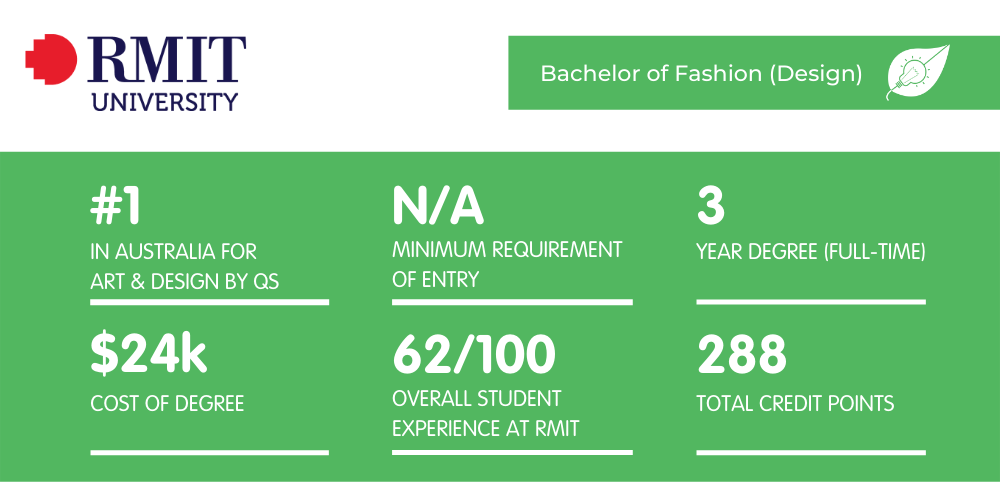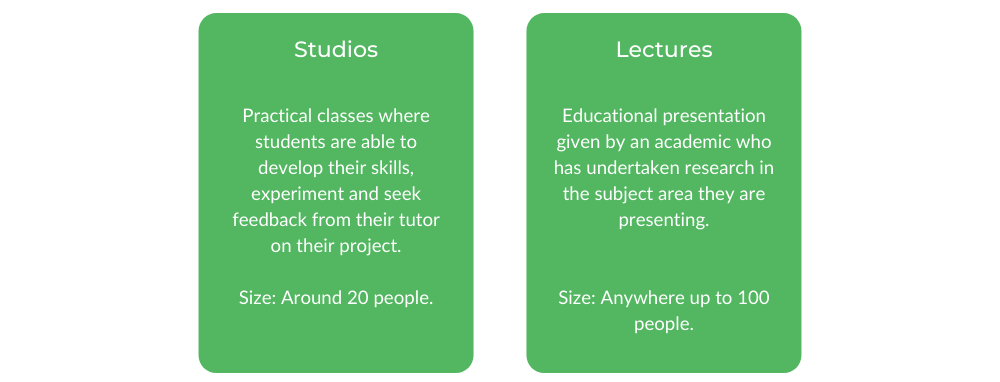Interested in studying a Bachelor of Fashion (Design) at RMIT but searching for more information before you make up your mind?
You’ve come to the right place as we’ll give you the run-down on everything you need to know about the degree, including the subjects, assessments, culture, faculty and more!
Let’s dive in!
What is a Bachelor of Fashion (Design) at RMIT?
Core Units for this Degree
How to Get into a Bachelor of Fashion (Design) at RMIT
What’s the Teaching Format?
What’s the Faculty and Culture Like?
What is a Bachelor of Fashion (Design) at RMIT?
A Bachelor of Fashion (Design) at RMIT is a 3-year degree that prepares students to enter the fashion industry and develop their knowledge of fashion design through a strong focus on practical, theoretical, and technical classes. Throughout your studies, you will be exposed to a wide range of design areas and will be encouraged to use your creative spirit to create conceptual and innovative designs!
Globally recognised as one the best fashion schools in the world, the RMIT School of Fashion and Textiles provides students with opportunities to form strong industry connections through participation in national and international showcases, events, and exhibitions, including the Melbourne Fashion Week (MFW) Student Collections Runway and Graduate Fashion Week (GFW) London International Catwalk.
Who should study a Bachelor of Fashion (Design)?
This degree is well suited to students with a competitive edge who are passionate about fashion and interested in channelling their creativity into innovative design processes. If you’re studying Applied Fashion Design and Technology, Art or Visual Communication Design, a Fashion degree may be just what you’re looking for!
Does this degree offer an Honours program?
If you’re looking to elevate your studies, high-achieving students who have completed the Bachelor of Fashion (Design) with a Grade Point Average (GPA) of at least 3.0 out of 4.0 are guaranteed entry into a Bachelor of Fashion (Design) (Honours).
Career Paths
A Bachelor of Fashion (Design) opens tons of doors in the fashion and design industry, varying from merchandising to design to business marketing. Whether you want to enter commercial practice, emerging design markets or luxury business, there are so many different options that you can explore.
Just a few of the potential roles you might find yourself in include:
- Fashion designer
- Stylist
- Creative director
- Product developer
- Creative pattern-maker
- Fashion project manager
- Buyers’ assistant
Core Units for this Degree
What are the Core Units?
Throughout your time studying a Bachelor of Fashion (Design) at RMIT, you will be expected to complete 13 core courses. These core units are focussed on fashion knowledge, material studies and professional practice to help you develop the theoretical knowledge and technical skills to apply your design expertise in the industry.
Here are the courses you’ll study year on year:
Year 1
- Introduction to Fashion Design Practice
- Fashion Expressions
- Fashion and Textiles Materials
- Fashion, Textiles, Place and Story
- Fashion Design Industry Techniques
- Fashion Design Reuse
Year 2
- Transform Fashion Design Materials
- Fashion Communication Design
- Fashion Design Partnered Project
Year 3
- Fashion Design Persona Project
- Fashion Design Strategies and Environments
- Fashion Design Project Launch
- Fashion Presentation Design
In first year subjects like Introduction to Fashion Design Practice and Fashion Expressions, you will be exposed to different ways of exploring, documenting and creating your ideas for conceptual fashion designs.
In your second year, you will expand on your use of conventional fashion design materials and concepts to create and present transformative fashion designs in subjects like Transform Fashion Design Materials and Fashion Communication Design.
In your third year, core units like Fashion Presentation Design and Fashion Design Project Launch are focussed on refining your skills of design presentation and demonstrating your fashion design practice to a professional standard.
Are there any majors?
While a Bachelor of Fashion (Design) at RMIT doesn’t have set majors to select from, you can choose to specialise through developing a minor in textile design, sustainable innovation, or fashion enterprise.
You may choose to explore a range of elective options offered in the program option list, such as Fashion Design Languages and Writing or Fashion Design Diversity, or you may choose to stick closely to a minor, it’s completely up to you!
Practical Experience
If you’re looking to gain some real-world industry experience, the Fashion and Textile Industry Placement is an elective that students can select to undertake a placement/internship as part of their learning experience!
This is a great opportunity to make new networks and develop a greater sense of your interests, however, the only drawback is that your placement needs to be self-sourced.
How to Get into a Bachelor of Fashion (Design) at RMIT
For Bachelor of Fashion (Design) at RMIT, the ATAR is not the main selection criteria for entry into the course.
Instead, entry is based on the assessment of your Fashion Design selection task, which involves applying with written submissions and a folio with 6-10 pages of your work.
Assumed Knowledge and Prerequisite Subjects
There is no assumed knowledge or prerequisites for a Bachelor of Fashion (Design) at RMIT apart from the successful completion of Year 12 in Australia or the equivalent, and a study score of at least 30 in English (EAL) or at least 25 in English other than EAL, or equivalent studies.
Pathway Programs
While RMIT doesn’t offer any formal pathways into this course, you can still gain entry if you don’t meet the course admission requirements, such as by successfully completing an Australian Cert IV or above and satisfying the Special Tertiary Admissions Test (STAT).
Students may also be eligible for entry into a Bachelor of Fashion (Design) through a range of adjustment factors that RMIT has in place, including Equity access schemes, the Elite Athlete Program and the Indigenous Access Program.
What scholarships are available?
The Marion Fletcher Fashion and Textiles Scholarship for commencing students worth up to $7000, and the Grathelms Scholarship for second year or Honours year students worth up to $7000 are two scholarships offered to support students studying a Bachelor of Fashion (Design) at RMIT.
What’s the Teaching Format?
A Bachelor of Fashion (Design) at RMIT is delivered across two semesters per year:
- Semester 1: Early March to Early June
- Semester 2: Late July to late October
Class Structure
Studios
Similar to tutorials, studios are your main design classes where you can expect to do a lot of practical work! Studios usually run for 4 hours twice a week and usually have around 20 people.
Unlike the traditional university experience, these classes are very similar to your high school lessons in which you can always expect to see the same people and the classes are very structured.
You will usually spend the class working together on a fashion design/concept, receive some homework, hand it in in the next class and continue developing on your ideas. Your third year studios usually become more complicated as you will have to become increasingly self-reliant by working on independent study.
Lectures
You will have a lecture for every class and they usually run for 1 hour but can go up to 2.5 hours! You can expect just under 100 people in attendance, and lectures often feature international and local guests who are experts in their area to share their industry experience.
How much time do you spend on campus?
If you study a Bachelor of Fashion (Design) at RMIT, you’ll usually take about 3-4 subjects per semester. As such, you’re usually looking at around 20 contact hours each week, for which you are expected to double that amount of study in your spare time!
What are the assessments like?
Assessments vary greatly between subjects, but the common link between all of them is a total lack of exams! Instead, you can expect to undertake a lot of practical assessments, design proposals, essays, and presentations throughout your degree.
For subjects based on fashion design practice, such as Fashion Design Industry Techniques, are based on conceptualising an idea and demonstrating your technical skills by designing and creating clothing items.
For subjects involving fashion theory, such as Fashion Design Languages and Writing, assessments are usually written-based and involve completing either an essay, presentation, or research project on a chosen concept.
In textile subjects, like Introduction to Textile Design Practice, assessments are usually technically based and involve a lot of investigation behind the use of fabrics and involves creating a construction booklet of textiles.
What skills do you develop?
The skills that you develop through a Bachelor of Fashion (Design) are highly practical and enable you to develop a technical flair for fashion design. You will gain experience with sewing, pattern-making, tailoring, 2D and 3D illustrations, design conceptualisation and more!
Additionally, a Bachelor of Fashion (Design) also allows you to explore your entrepreneurial side and develop your communication skills by offering several marketing and management centred subjects as part of a Fashion Enterprise Minor.
“I went into the course knowing a really basic level of sewing and now I make most of my own clothes, so I think that’s probably one of the strongest suits of the course.” — Antonia Delac, Bachelor of Fashion (Design) (Honours) Graduate at RMIT
What’s the Faculty and Culture Like?
Faculty
As a global leader in fashion and textiles education, the RMIT staff is made up of industry practitioners who are highly qualified experts in their fields of fashion and design. While the faculty is known to be highly supportive of supporting students in their career paths, the subjectivity and creativity of a fashion degree means that you should be prepared to receive criticism!
“It’s hard being in such a subjective course where you can do something to the best of your abilities and think it’s amazing, but because of the teacher’s personal taste, you can be marked lower.” — Antonia Delac
Culture
When you enter a Bachelor of Fashion (Design), you can expect to meet a lot of super passionate students who are willing to learn and support each other. At RMIT, the fashion community is at a separate and smaller campus at Brunswick campus, so the social life is created more through the classroom than by societies.
Unlike the wide mix of high school, you will be in a cohort of like-minded people who all want to be there and are motivated to work.
However, a drawback is that the workload of a fashion degree is very heavy, and you can expect a lot of long nights of work. At least everyone else is in the same boat!
Exchange Opportunities
“If you’re considering studying a Bachelor of Fashion (Design), keep in mind to look into exchange as it’s a really eye-opening experience and it’s a really big deal in the fashion industry.” — Antonia Delac
Students studying a Bachelor of Fashion (Design) have plenty of opportunities to gain international experience during their time at RMIT through semester programs, global work and volunteering internships or short term academic tours.
Ashley Sullivan is a Content Writer for Art of Smart Education and is currently undertaking a double degree in Communications (Journalism) and a Bachelor of Laws at UTS. Ashley’s articles have been published in The Comma and Central News. She is a film, fashion and fiction enthusiast who enjoys learning about philosophy, psychology and unsolved mysteries in her spare time.






